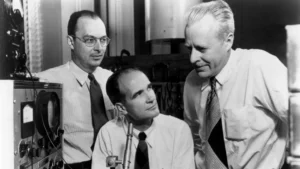Introduction:
Intel has been the dominant player in the semiconductor industry for decades. However, in recent years, the company did fall to competitors like AMD and TSMC.
There was a time Intel was worth more than Nvidia, AMD and TSMC combined. Now each of those upstarts is worth multiples of Intel. It’s a great lesson in strategy gone wrong.
During the 2010s, Intel allocated a staggering annual R&D budget exceeding $10 billion, surpassing TSMC’s spending fourfold and dwarfing even DARPA’s total budget by three times. In fact, only a few companies globally matched or exceeded Intel’s R&D investment during this period.
Intel seemed primed to dominate the chip industry as it transitioned into the era of Extreme Ultraviolet Lithography (EUV). The company had played a pivotal role in the development of EUV technology, with Andy Grove’s early investment of $200 million in the 1990s being a crucial factor.
After significant investments, particularly from Intel, ASML had successfully brought EUV technology to fruition. This breakthrough promised a future of smaller transistors, which Intel appeared ready to capitalize on.
However, Intel’s potential dominance was compromised as it failed to seize the opportunity presented by the EUV era. The company failed to adapt to significant shifts in semiconductor architecture necessary for artificial intelligence, a burgeoning field at the time.
Despite its continued profitability and status as the largest and most advanced chipmaker in the United States, Intel’s future has become increasingly uncertain. This uncertainty is reminiscent of the pivotal moment in the 1980s when Andy Grove decided to abandon memory and focus solely on microprocessors, ultimately securing Intel’s prominence.
Intel still possesses the potential to reclaim its leadership position in the industry in the coming years. However, it is also facing a risk of further decline and could find itself in a precarious position.
In this blog post, we will delve into the specific factors that hampered Intel’s innovation, examining in detail the strategic missteps and external influences that shaped this crucial decade.
Follow us on Linkedin for everything around Semiconductors & AI
1. Morris Chang and the Fabless Era led to The fall of Intel :
Morris Chang, the visionary founder of Taiwan Semiconductor Manufacturing Company (TSMC), spearheaded the fabless business model, a paradigm shift in the semiconductor industry. This model allowed companies to outsource manufacturing and focus solely on chip design. TSMC and other foundries excelled under this model, benefiting from access to advanced manufacturing technologies.
Conversely, Intel persisted with the Integrated Device Manufacturer (IDM) model, integrating chip design and manufacturing in-house. Intel’s perspective on maintaining an integrated model had its merits, but it also came with significant drawbacks.
TSMC, manufacturing chips for a multitude of companies, now produces almost three times the number of silicon wafers annually compared to Intel. This extensive production capacity allows TSMC more opportunities to refine its manufacturing processes continuously. Additionally, while Intel viewed emerging chip design startups as a threat, TSMC saw them as potential customers for their manufacturing services.
TSMC’s sole focus on effective manufacturing enabled its leadership to concentrate relentlessly on advancing semiconductor fabrication while reducing costs. On the other hand, Intel’s leadership had to divide their attention between chip design and manufacturing, ultimately resulting in challenges in both areas.
Read more: The Fall of Intel: How an MBA CEO’s Short term thinking destroyed a semiconductor giant
2. The fall of Intel : Emergence of Artificial Intelligence
By the early 2010s, Intel’s primary market, which involved supplying processors for personal computers (PCs), had hit a plateau. Unlike enthusiastic gamers, most people no longer eagerly upgraded their PCs with the release of new models, and few paid much attention to the type of processor inside their computers.
Intel’s other significant market was selling processors for servers used in data centers. This market experienced explosive growth during the 2010s as companies like Amazon Web Services, Microsoft Azure, and Google Cloud expanded their vast data center networks. These data centers powered the “cloud,” where much of our online data processing takes place. These data centers were filled with Intel chips.
However, just as Intel had established dominance in the data center market, a new computing trend emerged—artificial intelligence (AI). AI tasks were a challenge for Intel’s main chips, the central processing units (CPUs). CPUs were designed to be versatile, general-purpose workhorses, serving as the “brains” of computers and data centers. However, they weren’t well-suited for AI’s specific demands.
Nvidia Vs Intel
In the early 2010s, Nvidia started to hear rumors about PhD students at Stanford utilizing Nvidia’s graphics processing units (GPUs) for purposes beyond graphics. GPUs operated on a different principle than standard Intel or AMD CPUs. While CPUs were highly flexible and processed calculations sequentially, GPUs were designed for parallel processing—running multiple iterations of the same calculation simultaneously. This form of parallel processing proved to have applications beyond gaming, particularly in the efficient training of AI systems.
Instead of processing data in a linear fashion like a CPU, a GPU could simultaneously process multiple pieces of data, significantly accelerating AI training processes. For instance, in training a computer to recognize images of cats, a CPU would process pixel by pixel, while a GPU could process many pixels at once, drastically reducing the time needed for training.
The 2010s witnessed an AI revolution and a surge in parallel processing requirements for computationally intensive tasks. Nvidia, with its advanced GPU technology, became a preferred choice for AI applications. Nvidia’s early entry and dominance in this sector challenged Intel’s CPU-centric strategy.
Read more: What the hell is difference between CPU & GPU
3. The fall of Intel : Closed-off and Secretive Culture:
Intel’s closed-off and secretive corporate culture, especially when it came to private companies, which were also its competitors (while protecting proprietary information), restricted external collaborations and partnerships. This insular approach hindered the flow of diverse ideas and perspectives from external sources. In contrast, companies like TSMC embraced a more open and collaborative culture, forming partnerships with research institutions, startups, and other industry players.
For instance, TSMC actively collaborated with research universities and consortia to drive advancements in semiconductor technology. This open culture allowed for cross-pollination of ideas, ultimately fueling innovation. In contrast, Intel’s reluctance to open up impeded its ability to tap into a broader pool of knowledge and ideas.
“Bad companies are destroyed by crises; good companies survive them; great companies are improved by them.”
~Andy Grove, CEO, Intel
4. The fall of Intel : Delay in 7 & 10 nm Process:
Transitioning to smaller process nodes is crucial for chip performance, energy efficiency, and miniaturization. Intel faced significant delays in this transition, especially for 7 and 10 nm nodes due to complex semiconductor technology and challenging transistor size reduction.
Delays in 10 nm chip production, like the Cannon Lake microarchitecture, disrupted Intel’s product roadmap. Competitors gained an advantage by delivering advanced technologies to the market.
Intel’s transparency regarding these setbacks has been lacking. The company repeatedly cited “temporary” manufacturing delays over five years without specific technical details, often due to employee nondisclosure agreements.
5. The fall of Intel : Delayed Adoption of EUV
Extreme Ultraviolet Lithography (EUV) is pivotal for achieving smaller process nodes by using shorter wavelengths of light to etch smaller features on silicon wafers. However, integrating EUV technology into the manufacturing process proved challenging for Intel, leading to delays in the adoption of smaller nodes.
Many industry experts believe that a significant portion of the company’s challenges can be attributed to Intel’s delayed integration of EUV (Extreme Ultraviolet) tools. about half of the EUV lithography tools, initially supported and encouraged by Intel, were operational at TSMC. In contrast, Intel had just started implementing EUV in its manufacturing process and was significantly behind in its adoption compared to TSMC in 2020.
In contrast, companies like TSMC adopted EUV technology earlier, enabling them to achieve smaller process nodes like 7 nm and 5 nm sooner than Intel. This technological gap placed Intel at a disadvantage, affecting their ability to compete effectively in terms of chip efficiency and performance.
Read more: What is EUV that made ASML the biggest company of Europe
Conclusion:
By the close of the decade, only two companies dominated advanced processor production: TSMC and Samsung. The concern from the United States stemmed from their location. Both were situated in Taiwan and Korea, adjacent to the rising strategic rival, the People’s Republic of China.
The 2010s brought significant challenges for Intel, shaping its innovation landscape. Understanding these challenges is crucial for Intel’s strategic planning. As Intel strives to reestablish industry leadership, adapting to new business models and embracing emerging technologies is paramount. Fostering a collaborative culture and addressing manufacturing challenges are vital steps for Intel’s resurgence in the semiconductor domain.
Reference:
- Chip war by Chris Miller



